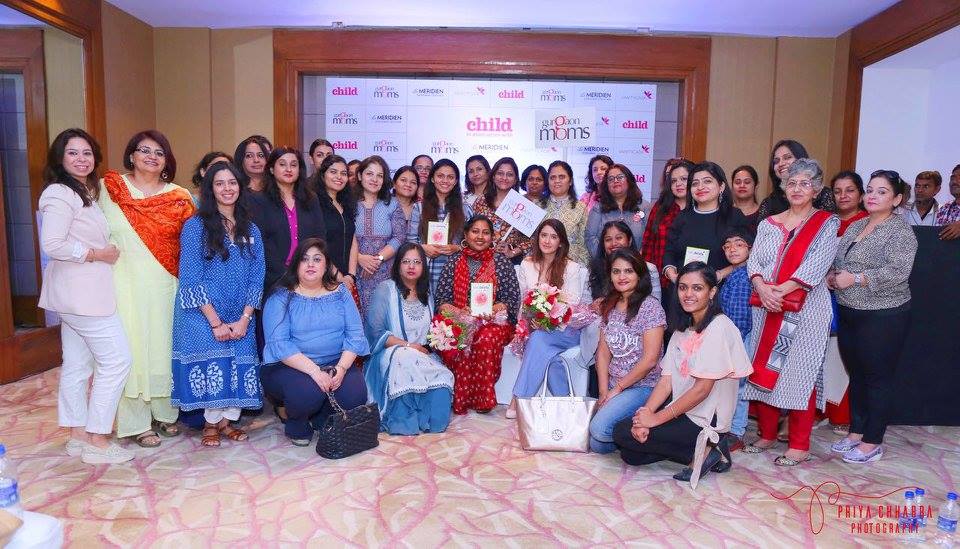Don’t know how to get your picky eater to chew on spinach or chomp down crunchy fruits? Worried if the kids are getting enough essential nutrients? Frustrated when the dinner table becomes a battleground? Or just confused with all the information (sometimes contradictory) available on and offline?
Celebrity nutritionist and noted author of Eat.Delete and Eat.Delete. Junior, Pooja Makhija, answered these and many more questions at an interactive Q&A session organized by Child Magazine with Gurgaon Moms at the Le Meridien, Gurgaon. Right of the bat, Pooja (the mother of two lovely girls) shared, “Nutrition is made out to be so complicated whereas it needn’t be”! A mother’s intuition (because you know your child best) and sticking to a nutritious balanced diet is really all that is required to getting your kid on the road to life-long healthy eating habits
As a mother of an 8-year-old boy and 6-year-old girl, ensuring that my kids eat healthy consumes a big chunk of my “Mommy life”. So I predictably jumped, hopped and skipped at the opportunity to speak to her! Here are excerpts from my interview and the Q&A session with Pooja:
Question: What was the inspiration behind Eat.Delete.Junior ? Please share your journey.
Answer: Eat.Delete.Junior stems from a very happy place. I started sowing the seeds of eating right with my daughters from the get-go and now that they are in their pre-teens, we’re reaping the benefits. They know what foods are good for them, when to indulge and when to cut back. Besides helping parents shape their kids into healthy eaters, I observed an increase in obesity and early onset of puberty amongst children compelling me to share my experience as a nutritionist and more importantly as a Mum to two happy and healthy girls. And although I’ve been able to counsel over 15,000 clients in the last 15 years of my career, my book would have a far wider reach and could benefit many more parents.

Question: Tell us about the book.
Answer: In a nutshell, the book is an age-wise (0 to 15 years) guide to childhood nutrition. The eating patterns of children change as they grow. Likewise, the challenges that parents face in terms of feeding their kids are different at every age group. If you teach kids good nutritional habits in their early years then they are likely to make nutritionally responsible choices as adults. My book offers age-specific solutions not only on what to feed your child but how your child eats. It focuses on the psychology of eating, keeping your child’s individual nutritional needs in mind. I use personal anecdotes, fairy tales and fables to make eating fun for kids and their parents.
Question: How can a parent of a fussy eater ensure their child gets the recommended amount of essential vitamins and minerals every day?
Answer: I’ll break this question down because different ages require different tactics to deal with a fussy eater. With kids below 5 years, it is important to understand the difference between nutritional independence and nutritional indiscipline. Disciplining and setting boundaries during this phase is sure to benefit the child in the end. Persistence and patience are imperative during this time. You may have to try one food, such as carrots, ten times before your child likes but your child will eventually get used to it. Use people your child idolizes such as family members or storybook characters and even cartoon characters to generate interest. For example, I’m sure you want to be smart like Dora so eat your carrots!
With older kids, one needs to use logic. “Fooducate” your child about the benefits of eating right and correlate nutrients to what they do for your child’s body. Spinach is rich in iron and iron is important for good skin, hair and even affects performance at school. This way they can be accountable for their health as well. Comparisons are never a good idea and can lead to resentment within the child. The pre-teen years are when eating disorders like Anorexia and Bulimia kick in and although it isn’t that widespread, do keep a lookout for the signs anyway.
To give you an idea of what to feed your child, please ensure they get the five most important nutrients or what I like to call the “Five Fingers of Nutrition”. These include carbs, protein, fats, vitamins, and minerals. Together these five fingers of nutrition make a fist and the job the parent is to make sure that this nutritional fist is a part of their child’s daily diet. The recommended dosages, as well as appealing meal plans, are listed in my book.
However I must mention that the older can a child, the more difficult it may be to change their eating habits which is why I always stress on “fooducating” our juniors, the younger the better. It is important to separate emotion from food so do not use food to reward or punish your child. Food is nothing more than your fuel for life.
Question: Considering we deal with high levels of pollution many children are subject to respiratory infections and low immunity. How can diet help?
Answer: Yes it is unfortunate that pollution is a reality of our lives. Saline water nebulization (much better than using steroids) is your best bet for immediate relief. To build immunity increase intake of Vitamin C and your pediatrician is likely to recommend Zinc and B12 supplements. Sound sleep is the best way to repair one’s body so kids need at least 10 to 14 hours of shut-eye depending on their age. The silver lining is that post the age of 5, such health issues reduce as your child’s immunity improves.

Question: As a mum of a vegetarian son how can I ensure that my child gets enough protein?
Answer: No offense to any religious beliefs but I personally feel that children need to include eggs in their diet. Lentils, beans, and vegetables are wonderful but they may not fulfill your child’s requirement of protein. Soya and other plant-based proteins are usually high in estrogen and too much of it could result in early puberty. Also, a lot of the milk available these days contains some level of hormones which again could tamper with your child’s hormonal balance. You may like to try brands that offer hormone-free milk and including curd and some amount of cheese in your child’s diet makes sense.
In case your child doesn’t like the taste of egg, then you can mask egg whites in dosa batter, mix it in your dough for parathas or try egg fried rice.
Question: You attend so many conferences, talks, and such sessions, what is the one message that you’d like to share with other parents?
Answer: I usually meet two kinds of mums. The ones that are super- particular about every single morsel that goes in their kid’s mouth and then there are those that just go with the flow and aren’t as concerned. We need to find a middle ground! You don’t need to be a nutritionist to ensure that your child is healthy and happy. A few basic principles, setting the right examples and using the methods mentioned in my book are really all you should need to make your kid a nutritious eater. For further assistance or specific answers, one can find me online at www.nourishgenie.com as well as at www.missionnutritionindia.com.
Images Courtesy : Priya Chhabra Photography






